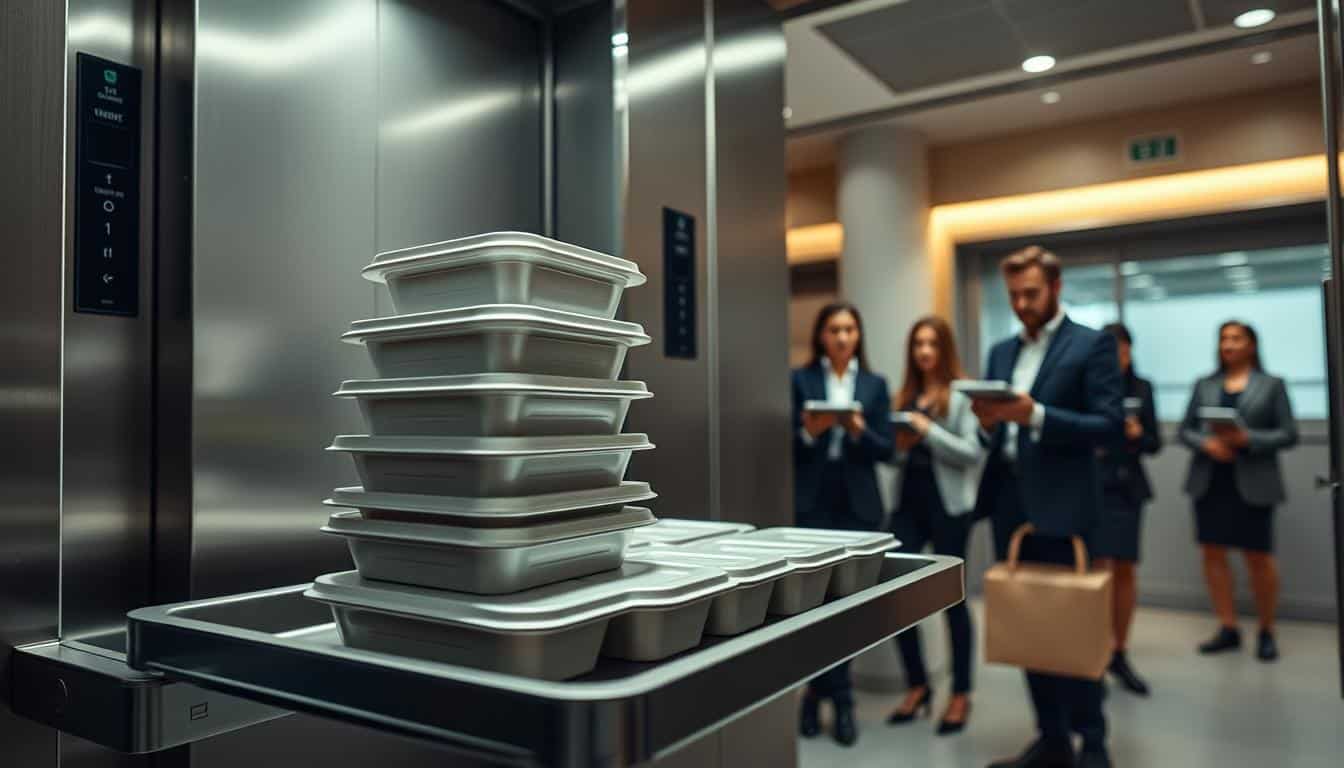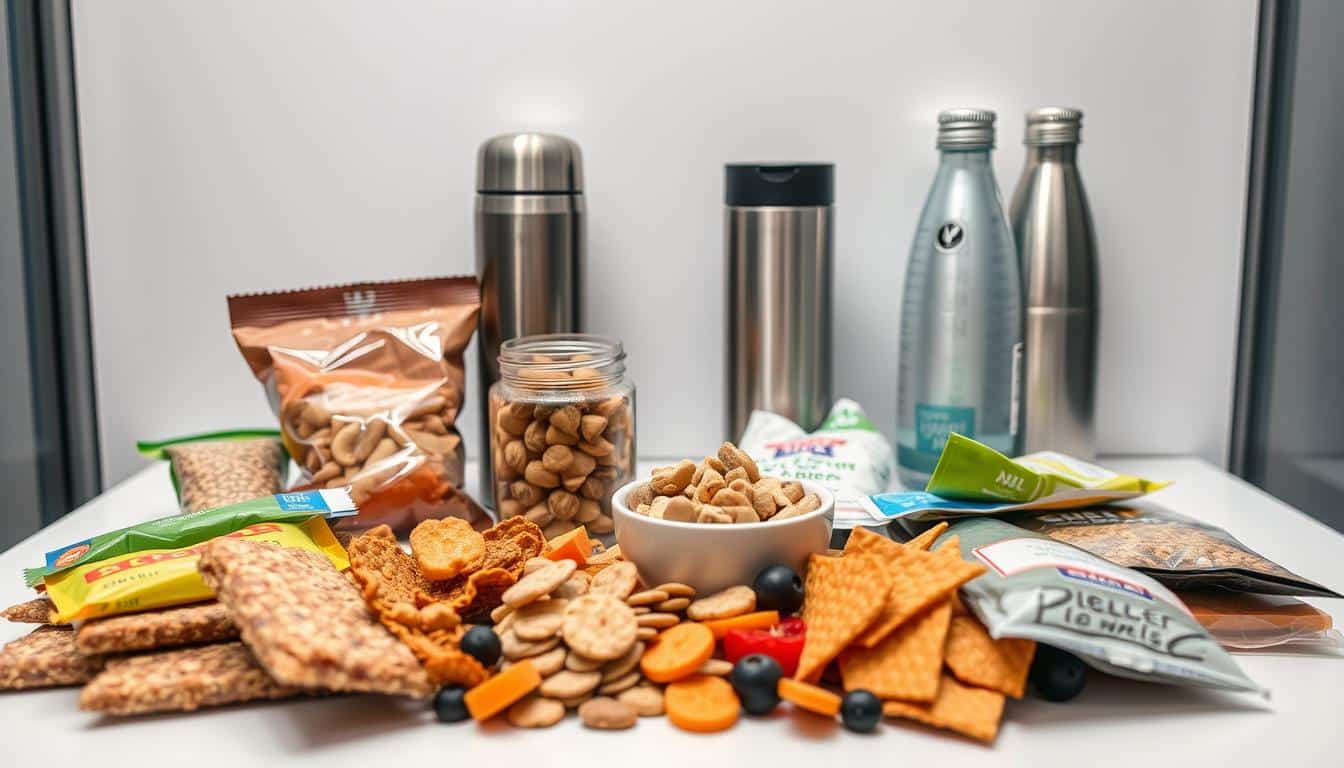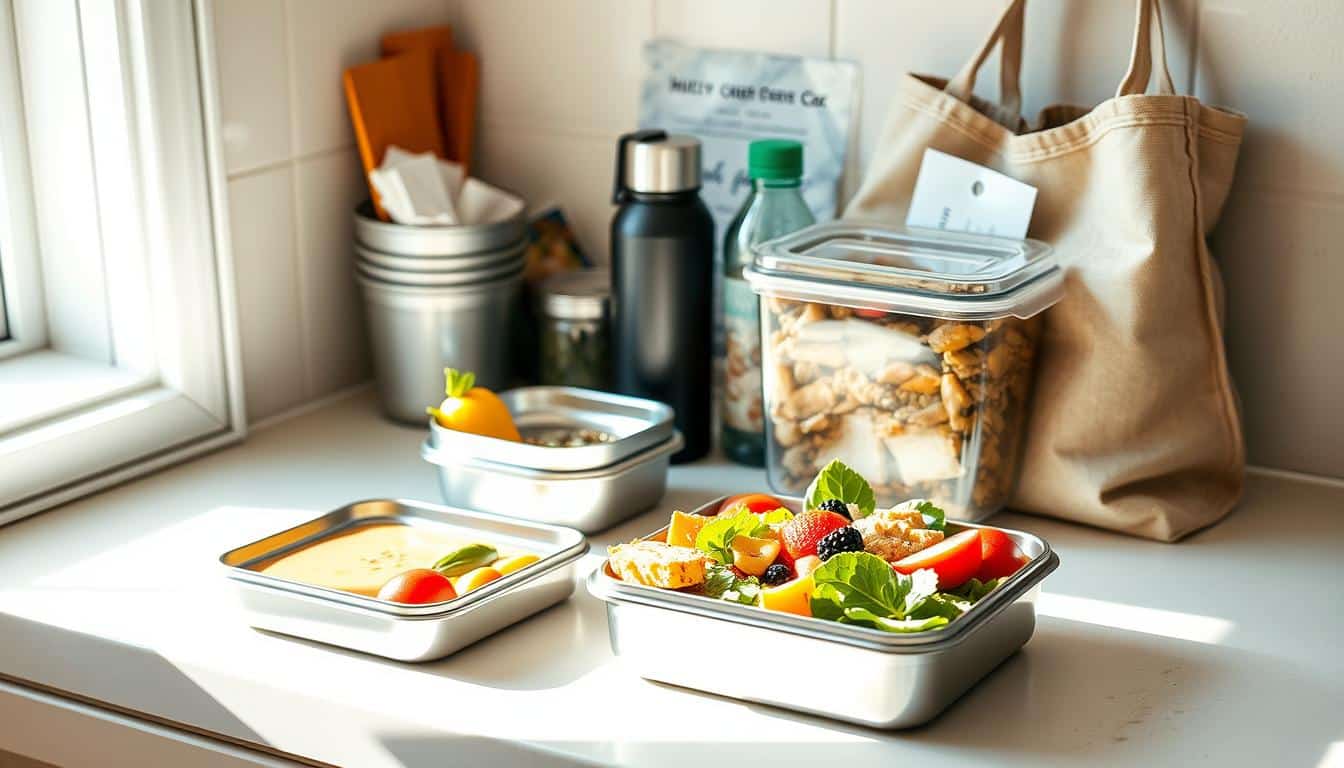In today’s fast-paced office life, eating right is tough. Portions that fit in an elevator ride can lead to better eating habits. With restaurants offering bigger meals, learning about portion control is key. This part offers easy tips for office meals. It shows how eating well boosts work performance and health.
Understanding Portion Control in the Office
Portion control is key for a healthy lifestyle at work. Many workers find it hard to eat properly with so many distractions, like too much food. They end up eating more than needed, especially with bigger meal sizes at restaurants and vending machines.
It’s important to know about larger portion sizes. This knowledge helps office employees manage their meals better. They can use simple methods like measuring servings or using smaller dishes. These steps help in building a healthier eating habit at work.
The Importance of Healthy Eating at Work
Eating well at work is key to improving employee health and their overall well-being. A good diet is crucial for keeping energy up all day. When people eat right, they focus better, do more, and aren’t as tired from bad food choices.
Making poor food choices can lead to gaining weight, feeling more stressed, and serious health problems. Eating well boosts morale and makes the office a happier place. Studies prove that healthy eaters are sharper and healthier, which means less sick days and more job happiness.
Wellness programs that focus on eating right can really help a company. By supporting a healthy diet, companies show they care about their employees’ health. This makes a better work environment for everybody.
Elevator-Friendly Portion Control Tips for Office Meals
Handling portion control at work helps with healthy eating and meal planning. It’s great for those with a busy schedule. Using meal containers helps manage portions and stick to a balanced diet all day.
Utilizing Smaller Containers for Meals
Small meal containers are a smart choice for portion control. They make you feel full with less food. By pre-measuring your food, you can avoid eating too much even when you’re swamped with work. Keep these ideas in mind:
- Opt for containers that are easy to carry and stack.
- Choose clear containers to make the contents visible and appealing.
- Pair various containers to create versatile meal options, making it simple to rotate meals throughout the week.
Choosing the Right Food Items
Choosing what to eat is crucial for portion control and health. Aim for a mix of nutrient-rich foods in your diet. Here are some tips:
- Incorporate fruits and vegetables that can easily fit into meal containers.
- Include whole grains for sustained energy during long workdays.
- Look for lean protein sources that can help keep you fuller for longer.
Creating a Healthy Workspace
Designing a healthy workspace boosts employee well-being. It promotes better eating habits in the office. An effective office design makes fruits and vegetables easy to get. This can be done with fruit baskets or salad bars in common spots, pushing employees to pick healthier snacks all day.
It’s key to cut down on high-calorie snacks. Companies should swap them for healthier picks, like whole grain snacks, nuts, and yogurt. Making a space that prefers healthy options helps employees adopt better eating habits.
Eating areas just for meals help make a healthy workspace. Comfy and welcoming spaces make employees eat slowly and be mindful, which improves digestion and satisfaction. Working with facilities management keeps these areas well-kept and open to use.
In the end, creating a healthy workspace with smart office design boosts employee well-being. It also builds a health culture in the organization.
The Role of Mobility Devices in the Office
Making sure everyone feels welcome at work means thinking about those who use mobility devices. We can make a big difference in health and happiness by adding accessible features, like self-serve stations. These stations let people pick their own meals, helping them feel more independent and satisfied.
Accessible self-serve stations
Adding accessible self-serve stations can lead to better eating habits at work. Here are a few reasons why:
- It makes things easier for employees with mobility devices.
- It allows everyone to pick healthy foods on their own.
- It shows that we care about making sure everyone feels included.
Companies need to check their food areas to make sure they work for people with mobility aids. A well-thought-out design makes it simple for everyone to find what they like to eat. This effort towards being more accessible helps everyone at work feel healthier and more involved.
Managing Food Portions Wisely
Managing food portions wisely is key to a healthier lifestyle. By knowing the right portion sizes, employees can better control their meals. There are many methods to help with this.
It’s crucial to look at nutrition labels for serving sizes. These labels tell us how much of a food equals one serving. This helps us understand how much to eat.
Using tools like measuring cups or food scales helps with mindful eating. Even if it seems hard at first, these tools give us a clear view of how much we’re eating. This promotes making healthier choices.
Being aware of portion sizes is important when eating out. Restaurant dishes often give you more than the usual portion sizes. This can make us eat more than we need. You could share a meal or ask for a smaller portion to stay on track with your goals.
Being more aware can lead to better eating habits and help with weight management. Paying attention to food portions can make us healthier and improve our well-being.
Addressing Emotional Eating in Office Settings
Workplaces are common spots for emotional eating, especially with job stress. Tight deadlines and big workloads push people towards comfort food. Understanding why we overeat at work is key to picking healthier habits.
Recognizing Triggers for Overeating
It’s important to know what causes emotional eating. Triggers often include:
- Boredom during repetitive tasks
- Stress from overwhelming responsibilities
- Social cues during office gatherings and celebrations
Finding out these triggers helps employees handle their reactions better. For example, choosing healthy snacks or talking about ways to beat stress helps. Open talks about feelings can increase resistance to emotional eating. This encourages wise food choices.
Healthy Snacking Alternatives
Picking healthy snacks at work can really boost energy and productivity. Office snacks often include things like chips and cookies. These can make you feel tired and lead to more cravings. Instead, choose better snacks that are good for you and easy to eat.
Think about bringing different healthy snacks to keep at your desk. Here are some great choices:
- Nut mixes, which have healthy fats and protein to keep you going.
- Greek yogurt, full of protein and probiotics, for a great morning boost.
- Fresh fruits like apples, bananas, or berries, which have natural sugars and fiber.
- Vegetable sticks with hummus for a crunchy and healthy snack.
Having these healthy snacks at your workspace helps you snack better. It’s good for your health and makes you feel great. Being ready with healthy choices makes it easier to avoid bad snacks during the day.

Strategies for Eating Mindfully at Work
Bringing mindful eating to the office can really change how employees see food. One tip is to chew your food slowly. This helps with digestion and lets you enjoy the taste more. It makes you focus on your meal, making it more fun.
It’s also key to eat without distractions. When you fully pay attention to eating, you know when you’re hungry or full. Avoid doing other things like using the computer or checking your phone while eating. This helps prevent eating too much and feeling less satisfied.
Making small changes to support mindful eating at work can increase productivity and health. Creating spaces just for eating or setting specific times for meals helps. People can eat without being disturbed. This way, companies help everyone eat better and feel better.
How to Meal Prep for Office Days
Meal prep is a life saver for enjoying tasty office lunches. It helps keep meals balanced and portions in check. Planning ahead means you can skip the unhealthy takeout, staying energized and sharp all day. Here’s how to make meal prep work for office meals.
Portion Control Meal Prep Ideas
Portion control helps meet nutritional goals. Try these on-the-go lunch ideas:
- Prepare grain bowls using quinoa or brown rice. Top with various veggies and lean proteins.
- Make wraps with whole wheat tortillas. Fill them with turkey, spinach, and hummus for easy carrying.
- Create single-serving salad jars. Put dressing at the bottom and greens on top to keep it fresh.
- Batch-cook soups or stews, and put them in portioned containers for swift microwaving.
Balancing Nutrients in Office Meals
For energy at work, meals must be balanced. Follow these tips for a nutrient-rich lunch:
- Include proteins like chicken, legumes, or nuts to feel full longer.
- Use healthy fats, such as avocado or olive oil, for heart health.
- Eat a variety of colorful vegetables to boost vitamin and mineral intake.
- Make sure to have complex carbs, like whole grains, for lasting energy.
Dining Out: Making Smart Portion Choices
When you eat out, big meal portions can be tough to handle. This is especially true at places that serve a lot. For folks who want to stay healthy, choosing the right portion size is key. Sharing meals with friends at work is a great idea. It lets you enjoy different tastes and keeps the calories in check.
Choosing smaller plates or starters is another smart move. It helps satisfy your hunger without too much food. Also, it’s important to be mindful when meals are large. Many places have lighter, healthier options that fit well with eating right.
Talking to your server about portion sizes can make your meal better suited for you. Many restaurants are happy to change sizes or make tweaks to dishes. These tips can make eating out enjoyable and good for your health too.
Conclusion
Let’s sum up our journey into office wellness. Remember, small portion sizes are key to staying healthy in bustling work settings. By using the tips we talked about, everyone at work can eat better, even when it’s hectic. Choosing smaller plates, picking healthier snacks, and focusing on well-rounded meals help a lot.
This advice on healthy eating urges us to make wise food choices at work. By controlling portion sizes and selecting nutritious foods, we can feel more energized and work better. It’s not just about the food; it’s about caring for our health to improve our life inside and outside work.
To wrap things up, using these easy tips can change the way you eat at work for the better. It not only helps you but also promotes a culture of thoughtful eating at work. Keep these ideas in mind, and push for a work environment that values healthy eating and wellness for everyone.



